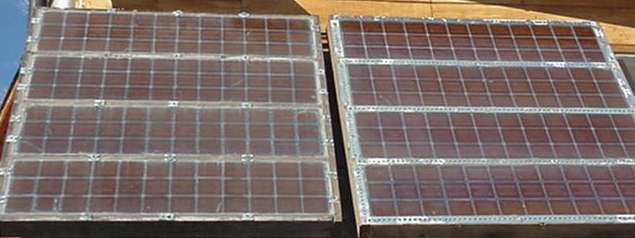
Used solar panels are usually a great bargain. Unless there is obvious major damage, you are most likely making a very safe and thrifty purchase--and if you can test the panels with a multimeter in full sunlight before purchase, you are almost guaranteed a functional panel. Nobody really knows what the lifespan of a solar panel is, since many of the very first panels are still in operation. I have three very old Arcos on my house, and they are still performing well. However, used panel prices have
Things to watch for when purchasing used solar panels- Newer panels pack more wattage into less space. If you don't have to worry about space, older used panels will almost always be your best deal for "dollars per watt."
- Avoid panels with obvious damage, unless you are willing to dig in there and fix them. Cracked glass, condensation under the glass, and broken connections are common problems, but can sometimes be fixed.
- In our experience, solar panels that are new from the factory usually put out up to 10 percent more than the rated output printed on their backsides. As they age, power output will decrease slightly during the panel's lifespan (but only if it has been in the sun the whole time... stored panels do not degrade!) The old Arco panel shown above was rated at 22 watts when brand new in 1980. It now produces about 19 watts. Not bad for 21 years in the sun!
- Older panels were made with a plastic substrate that turned brown after many years in the sun. Mirror concentrators made this problem very serious. Compare the difference in browning between the old Arco shown above (no concentrator) and the Carrizo quads below (mirror concentrators). But don't discount panels that have turned brown! Measure the actual power output, and make your decision based on that. Panels that have browned will not degrade any more rapidly than ones that are still clear.
- Another common problem with used panels is burned-out bypass diodes. These can be easily fixed, and might get you a great deal on "worthless" fried-out solar panels. Check out Windy Dankoff's article on diagnosing and repairing broken solar panels at left for more information.
- Loose connections between the actual solar cells in a panel can be a problem. This was the main problem with the "broken" solar panels that were previously for sale on our site (we are out of stock on these now.) Broken connections can be fixed by soldering...you must use electronics solder that contains at least 2 percent silver. Customers have told us that conductive epoxy works great for this, with much less hassle than solder. See our Solar Panel Repair page for more information. I think it's available from Radio Shack now too!
- To test a used solar panel, set your voltmeter to DC volts, and measure across the + and - terminals of the panel. This is called the "open-circuit voltage." A 12 volt panel should show about 21 volts in full sun. Panels designed to be connected in sets of 4 (4 panels in series) will show 4 to 5 volts. If your meter can measure DC amperes, set it for this (on a high enough range so your meter won't go up in smoke) and connect it between the + and - terminals in full sun. This measurement is called the short circuit current, and is how much current you can expect from the panels. For a 12 volt panel, multiply your current by 17 volts to get watts. (17 volts is the rated voltage of most 12 volt panels.)
- Used panels that are visibly brown in color (see photo below) are probably surplus from the Carrizo solar power plant in California. These were a hot item a few years ago, and the price was very low. Most were made to work only in sets of 4 ("quadlams") for charging 12V batteries. Others were made to run in sets of 3 ("trilams"). The surplus panels were graded by actual power output, from "gold" to "silver" down to "mud." Some of the better modules were mounted in aluminum frames by the salvage/resale company, others were sold without frames. The browning on these panels was caused by the use of mirrored concentrators, which increased power output dramatically, but caused browning of the plastic substrate and substantially reduced power output. However, they still make power! Don't be afraid of old Carrizo panels...just make sure you test them for power output before buying, especially if they were mounted in DIY frames by the original buyer. I mounted my pair of Carrizo "mud-quality" quads (in the photo below) in homemade wooden frames. The substantial browning of the "mud" modules reduced power output to only 75 watts for the whole quad...but they were sure cheap, and I figure every 75 watts helps, especially considering the very cheap price!

